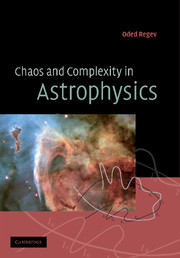Book contents
- Frontmatter
- Contents
- Preface
- Acknowledgements
- Part I Dynamical systems – general
- 1 Introduction to Part I
- 2 Astrophysical examples
- 3 Mathematical properties of dynamical systems
- 4 Properties of chaotic dynamics
- 5 Analysis of time series
- 6 Regular and irregular motion in Hamiltonian systems
- 7 Extended systems – instabilities and patterns
- Part II Astrophysical applications
- References
- Index
7 - Extended systems – instabilities and patterns
Published online by Cambridge University Press: 14 January 2010
- Frontmatter
- Contents
- Preface
- Acknowledgements
- Part I Dynamical systems – general
- 1 Introduction to Part I
- 2 Astrophysical examples
- 3 Mathematical properties of dynamical systems
- 4 Properties of chaotic dynamics
- 5 Analysis of time series
- 6 Regular and irregular motion in Hamiltonian systems
- 7 Extended systems – instabilities and patterns
- Part II Astrophysical applications
- References
- Index
Summary
Not to be born is the best for man
The second best is a formal order
The dance's pattern, dance while you can.
Dance, dance for the figure is easy
The tune is catchy and will not stop
Dance till the stars come down with the rafters
Dance, dance, dance till you drop.
W. H. Auden, Letter from Iceland.Spatially extended physical systems are naturally described by partial differential equations (PDE), which reflect the spatial structure of the system in addition to its time evolution. Classical examples in this context are fluid systems, described by the Euler or Navier–Stokes equations. Extended systems having several constituents that can react with each other and diffuse in space, are another well known example. These systems (like, e.g., mixtures of appropriate chemical species) are described by PDEs of the reaction–diffusion type. Many systems are only properly described when several types of process (e.g., fluid–dynamical and reactive–diffusive) are taken into account. A fluid system with heating and cooling processes as well as heat conduction operating within it is an example of such a system.
When we are dealing with only temporal evolution of a physical system, the dynamical system describing it consists of ODE or discrete maps. We have seen in Chapter 3 that near the threshold of an instability it is often possible to reduce the dimension of such systems and obtain a small set of amplitude equations, which faithfully describe the essential features of the system near marginality. A spatiotemporal PDE (the independent variables include coordinates and time) can be regarded as the infinite limit (n → ∞), of a system of n-coupled ODEs.
- Type
- Chapter
- Information
- Chaos and Complexity in Astrophysics , pp. 201 - 254Publisher: Cambridge University PressPrint publication year: 2006



